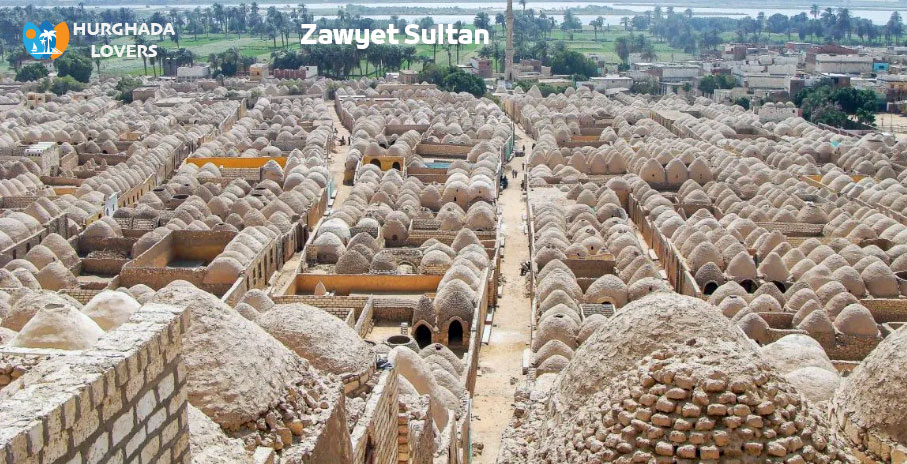Zawyet Sultan “‘Zawyet el-Mayyitin” in Minya, Egypt | Facts Zawyet el-Sultan “Zawyet el-Amwat” or corner of the dead, History, Map, Entrance Ticket, Opening Hours and more…
Facts and history of the construction of the most important Pharaonic archaeological sites on the eastern bank of the Nile River, and the tombs, temples and relics of the ancient civilization of ancient Egypt, the Pharaohs, and how much is the entrance ticket price, working hours and more.
Zawiya Sultan or Zawiya of Death is that small village that witnessed many civilizations from the beginning of history, such as the Pharaonic, Greek and Coptic civilizations. However, the predominant character of the village, which attracts tourists, is the Islamic style.
This village was a witness to an important political and social era in the history of Egypt, the period of the 1919 revolution. The most important feature of this village is the unique architectural style of the tombs.
Hurghada lovers Offer Luxury Hurghada to Luxor Tours | El Gouna to Luxor Tours | Makadi bay to Luxor Tours | Sahl Hasheesh to Luxor Tours | Soma bay to Luxor Tours.
Zawyet Sultan
Where is Zawiyat Sultan Village?
● The village of Sultan Zawiya Sultan is located in Upper Egypt, Minya Governorate, about 7 km away from the eastern bank of the Nile. And near the archaeological area of Tuna Mountain.
Why was the Sultan’s corner called that name?
● Sultan Zawiya was named by this name in relation to Muhammad Sultan Pasha Omda, who came from the Hijaz to settle in Egypt and later became the mayor of this village. He also later assumed the presidency of the first parliament established in Egypt. The village was later named after him because of his generosity and generosity. He built the first school in the village to educate its children, and he also built a mosque. Because of his generosity, people called him (King of Upper Egypt).
● Muhammad Pasha Sultan is the father of a pioneer of the feminist movement in Egypt, Huda Shaarawy, wife of Ali Pasha Shaarawy, a member of the Wafd Party and a close friend of Saad Pasha Zaghloul, leader of the 1919 revolution. Huda Shaarawy was buried in Zawiyat Sultan.
● In the Pharaonic era, this area was called (Habnu), and it was the capital of the sixteenth region of Upper Egypt.
Why was Sultan’s corner called the corner of the dead?
● Archaeologists describe the area’s Sultan Zawiya as a huge cemetery or a sea of tombs. It contains many tombs with a unique architectural style throughout the ages. Which attracts many tourists.
● In modern history in the year 1860, Muhammad Pasha Sultan built a high-rise building in the Islamic style on an area of 1,750 square meters to serve as family tombs. And the construction of these tombs French engineers. These tombs were carved from rocks and mountains. Each tomb is surmounted by a dome resembling the Dome of the Rock. Later, the residents of the village imitated this cemetery, and it became the dominant style in the whole village, so it was called by this name.
● Many important figures were buried in these tombs beside Muhammad Pasha Sultan, including his daughter Asma, whose grave is distinguished by unique inscriptions, and (Naela Hanim Sultan), sister of Muhammad Pasha Sultan and mother of artist Jamil Ratib.
● Some tombs were built of red brick, and some were built of adobe. However, all are decorated with either granite, marble or charcoal black. Many Islamic texts are written on it. All of them consist of one or two floors.
● Huda Shaarawy’s tomb is distinguished by a wonderful architectural style. Her name and the date of her death are engraved on the tomb with pure gold water. The tomb is decorated with colored granite and marble slabs. Her picture was hung on top of the cemetery. The cemetery consists of two floors, the first floor of which contains all the medals and awards it received. The doors of the tomb are made of arabesque, which was characteristic of Islamic architecture.
● The tombs of Muhammad Pasha Sultan contain a wide courtyard with an external staircase that was built to be a break for the family when visiting the tombs, and it is also characterized by a distinctive Islamic style.
What are the other monuments in Zawyet Sultan?
● The tomb of King (Khans), the ruler of the sixteenth province, was called the chief of all priests, the great ruler of the land and the guide of the land.
● The tomb of Neferu Sekhro, who was the king’s clerk and supervisor of the stores of Upper and Lower Egypt.
● The tomb of Ni Ankhpbi, which dates back to the era of the New Kingdom.
● The remains of the pyramid of King Hanbo, which was a step pyramid and ended up with a broken stone base of limestone, and it dates back to the Third Dynasty.
● Antiquities have been found dating back to the Greek and Roman era.
● Other Islamic and Coptic tombs of a unique style, some of which were built more than a thousand years ago.
● Funerary temples with domes, some of which have been converted into mausoleums.
● Civil living buildings built in the Islamic style, consisting of a salamlik, a harem, a number of stores and a water well. Champollion described and codified it in his book on Egypt.
What is the price of a ticket to visit Zawyet Sultan for the Egyptians?
● The fee for a visitor ticket to Sultan Zawia for adults is 10 Egyptian pounds.
● As for the ticket fees for visiting Sultan’s Corner for students, it is: 5 Egyptian pounds
What is the price of a ticket to visit Zawyet Sultan for foreigners?
● The fees for a visitor ticket to Sultan Zawia for foreigners: 40 Egyptian pounds
● If the visitor is a foreign student, the entry fee is 20 Egyptian pounds.

